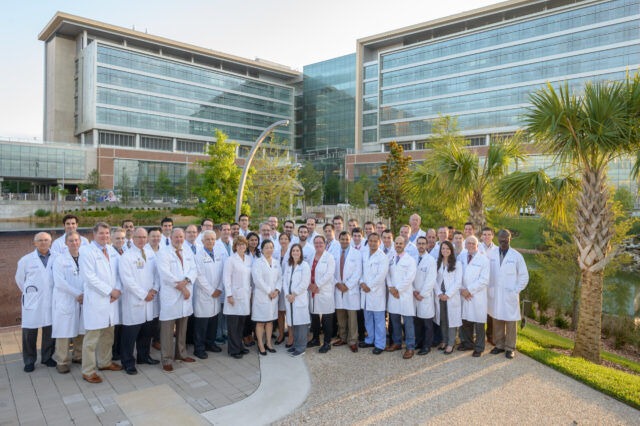University of Florida Health is a Leader in Cardiovascular Care
The University of Florida Health Divisions of Cardiovascular Medicine and Surgery are working together as leaders in the care of our patients in Florida and…

Update your location to show providers, locations, and services closest to you.
Endovascular abdominal aortic aneurysm (AAA) repair is surgery to repair a widened area in your aorta. This is called an aneurysm. The aorta is the large artery that carries blood from your heart to your belly, pelvis, and legs.
An aortic aneurysm is when a part of this artery becomes too large or balloons outward. It occurs due to weakness in the wall of the artery.
EVAR; Endovascular aneurysm repair - aorta; AAA repair - endovascular; Repair - aortic aneurysm - endovascular
This procedure is done in an operating room, in the radiology department of the hospital, or in a catheterization lab. You will lie on a padded table. You may receive general anesthesia (you are asleep and pain-free) or epidural or spinal anesthesia. During the procedure, your surgeon will:
Endovascular aneurysm repair (EVAR) is done because your aneurysm is very large, growing quickly, or is leaking or bleeding.
You may have an AAA that is not causing any symptoms or problems. Your health care provider may have found this problem when you had an ultrasound or CT scan for another reason. There is a risk that this aneurysm may burst (rupture) if you do not have surgery to repair it. However, surgery to repair the aneurysm may also be risky. In such cases, EVAR is an option.
You and your provider must decide whether the risk of having this surgery is smaller than the risk for rupture if you do not have surgery to repair the problem. The provider is more likely to recommend that you have surgery if the aneurysm is:
EVAR has a lower risk of developing complications compared to open surgery. Your provider is more likely to suggest this type of repair if you have other serious medical problems or are an older person.
Risks of any surgery are:
Risks of this surgery are:
Your provider will examine you and order tests before you have surgery.
Always tell your provider what drugs you are taking, even drugs, supplements, or herbs you bought without a prescription.
If you are a smoker, you should stop. Your provider can help. Here are other things you will need to do before your surgery:
The evening before your surgery:
On the day of your surgery:
Most people stay in the hospital for a few days after this surgery, depending on the type of procedure they had. Most often, the recovery from this procedure is faster and with less pain than with open surgery. Also, you will most likely be able to go home sooner.
During a hospital stay, you may:
Recovery after endovascular repair is quick in most cases.
You will need to be watched and checked regularly to make sure your repaired aortic aneurysm is not leaking blood.
Braverman AC, Schemerhorn M. Diseases of the aorta. In: Libby P, Bonow RO, Mann DL, Tomaselli GF, Bhatt DL, Solomon SD, eds. Braunwald's Heart Disease: A Textbook of Cardiovascular Medicine. 12th ed. Philadelphia, PA: Elsevier; 2022:chap 42.
Brinster CJ, Sternbergh WC. Endovascular aneurysm repair techniques. In: Sidawy AN, Perler BA, eds. Rutherford's Vascular Surgery and Endovascular Therapy. 10th ed. Philadelphia, PA: Elsevier; 2023:chap 74.
Fanelli F, Falcone GM. Endovascular aortic repair. In: Mauro MA, Murphy KP, Thomson KR, Venbrux AC, Morgan RA, eds. Image-Guided Interventions. 3rd ed. Philadelphia, PA: Elsevier; 2021:chap 20.
The University of Florida Health Divisions of Cardiovascular Medicine and Surgery are working together as leaders in the care of our patients in Florida and…

January 29, 2015
A surgeon at University of Florida Health is currently the only researcher in the nation conducting a study of three specific, unique types of devices to treat…
Department of Surgery, +2 more